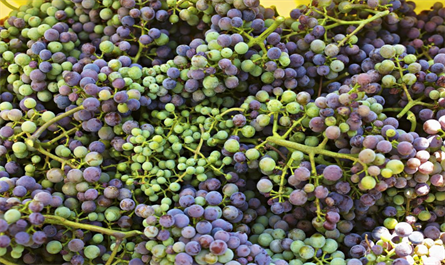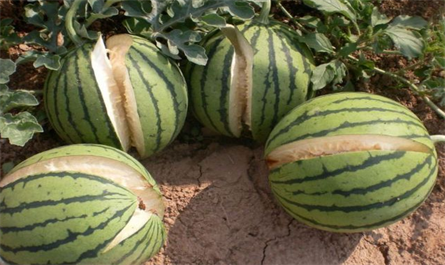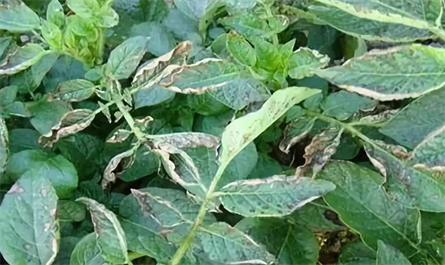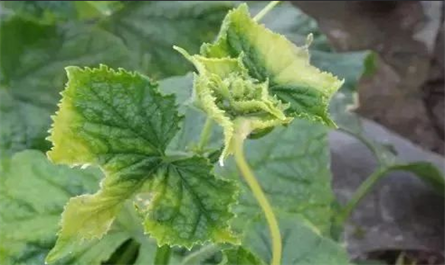Problems and case analysis of drug harmfulness in the use of plant growth regulators
The effect of plant growth regulators is affected by many factors, including crop types, growth stages, application sites, regulator types, concentrations, application methods, and external environments.
In the process of using plant growth regulators, the problem of pesticide damage is particularly prominent. This article will analyze the causes of plant growth regulator damage through five real cases of crop pesticide damage.
1. improper use period is an important cause of pesticide damage.
There are strict regulations on the timing of the use of plant growth regulators. If the application period is not chosen properly, it will cause pesticide damage, which will result in a reduction in yield or even a loss of grain. Taking the application of Forchlorfenuron on watermelon as an example, in late May 2011, the watermelons of villagers in Yanling Town, Danyang City, Jiangsu Province, burst due to the use of "watermelon expansion hormone". In fact, the bursting of watermelons is not directly caused by watermelon expansion hormone, but is caused by its use at an inappropriate time. Forchlorfenuron, the appropriate use period is the day of watermelon flowering or one day before and after, and the concentration of 10-20μg/g is applied to the melon embryo. However, if the watermelon is used after the diameter exceeds 15cm, it will cause phytotoxicity, which is manifested as hollow watermelon, loose flesh, reduced sweetness and poor taste. In severe cases, it may even cause the watermelon to burst. At the same time, because Forchlorfenuron is not conductive, if the watermelon is not evenly coated, it may also produce deformed watermelons.
2. incorrect dosage is also a common cause of phytotoxicity.
Each plant growth regulator has its specific dosage range.
Too low a dosage cannot achieve the expected effect, while too high a dosage may cause phytotoxicity. Taking the application of Ethephon on grape coloring as an example, in 2010, fruit farmers in Mianyang, Sichuan found that the grapes they planted fell off before they were fully ripe, which may be due to improper use of Ethephon.
Analysis: Ethephon performs well in promoting grape coloring, but different grape varieties need to pay attention to adjusting the concentration when using it. Therefore, the concentration must be strictly controlled, and the strategy of spraying, harvesting and selling in stages must be adopted to avoid unnecessary losses. The farmer failed to distinguish between grapes of different varieties and growth cycles and sprayed them all with 500μg/g of Ethephon, which ultimately caused a large amount of grape falling.

3.Different crop varieties have different sensitivities to the same plant growth regulator
Since various crop varieties have different sensitivities to the same plant growth regulator, caution must be exercised when using it. Small-scale tests should be conducted first to confirm that it is safe and effective before it is promoted and applied. For example, α-Naphthyl Acetic Acid is a widely used flower-preserving, fruit-preserving and fruit-swelling agent, which often has significant effects on cotton, fruit trees and melons. However, different crops have different sensitivities to it. For example, watermelon is highly sensitive to α-Naphthyl Acetic Acid, and the concentration used must be strictly controlled, otherwise it may cause pesticide damage. The melon farmer did not consider the particularity of watermelon and sprayed it according to the general concentration in the instructions, resulting in the flipping of the watermelon leaves.

4.Improper use leads to pesticide damage
Even if the same plant growth regulator is applied to the same crop, it may cause pesticide damage if it is not used correctly. For example, the application of Gibberellic Acid (GA3) on grapes requires accurate timing and concentration. If used improperly, such as spraying instead of dipping the fruit clusters, it will lead to different fruit sizes, seriously affecting yield and quality.
5.Random compounding of plant growth regulators
In addition, random compounding of plant growth regulators may also cause problems. There may be interactions between different plant growth regulators, resulting in unstable efficacy or adverse reactions. Therefore, professional guidance should be followed when using them to ensure safety and effectiveness.
The compounding technology of plant growth regulators can often achieve synergistic effects after careful formula screening and field test verification.

6.Other cases of non-standard use of drugs
When using plant growth regulators, the correct method, time and concentration must be strictly followed to ensure that they play their due role and avoid drug damage. For example, the application of paclobutrazol on apple trees may cause serious effects if it is used improperly. When the apple trees have grown into productive plants, applying 2 to 3 grams of Paclobutrazol to the roots of each tree about 5 meters around in autumn for one week can effectively control the growth of new shoots in the second year, and it is still effective in the third year. However, if Paclobutrazol is sprayed at a concentration of 300 micrograms/gram when the new shoots of apple trees grow to 5 to 10 cm, although it can inhibit the growth of new shoots, if the dosage is improper, it may hinder the normal growth of apple trees, resulting in reduced yield and reduced fruit quality.

In addition, environmental conditions are also key factors affecting the effectiveness of plant growth regulators.
For example, the effect of 1-Naphthyl Acetic Acid on tomato fruit preservation is affected by temperature. When the temperature is below 20℃ or above 35℃, the fruit preservation effect is not good; while in the temperature range of 25-30℃, the fruit preservation effect is most ideal. Similarly, the application of Forchlorfenuron on cucumbers also needs to pay attention to the timing. It should be used on the day when the cucumber blooms. If the timing is missed or the dosage is inappropriate, the cucumber may continue to grow in the refrigerator, but the taste and quality will be significantly reduced.
In the process of using plant growth regulators, the problem of pesticide damage is particularly prominent. This article will analyze the causes of plant growth regulator damage through five real cases of crop pesticide damage.
1. improper use period is an important cause of pesticide damage.
There are strict regulations on the timing of the use of plant growth regulators. If the application period is not chosen properly, it will cause pesticide damage, which will result in a reduction in yield or even a loss of grain. Taking the application of Forchlorfenuron on watermelon as an example, in late May 2011, the watermelons of villagers in Yanling Town, Danyang City, Jiangsu Province, burst due to the use of "watermelon expansion hormone". In fact, the bursting of watermelons is not directly caused by watermelon expansion hormone, but is caused by its use at an inappropriate time. Forchlorfenuron, the appropriate use period is the day of watermelon flowering or one day before and after, and the concentration of 10-20μg/g is applied to the melon embryo. However, if the watermelon is used after the diameter exceeds 15cm, it will cause phytotoxicity, which is manifested as hollow watermelon, loose flesh, reduced sweetness and poor taste. In severe cases, it may even cause the watermelon to burst. At the same time, because Forchlorfenuron is not conductive, if the watermelon is not evenly coated, it may also produce deformed watermelons.
2. incorrect dosage is also a common cause of phytotoxicity.
Each plant growth regulator has its specific dosage range.
Too low a dosage cannot achieve the expected effect, while too high a dosage may cause phytotoxicity. Taking the application of Ethephon on grape coloring as an example, in 2010, fruit farmers in Mianyang, Sichuan found that the grapes they planted fell off before they were fully ripe, which may be due to improper use of Ethephon.
Analysis: Ethephon performs well in promoting grape coloring, but different grape varieties need to pay attention to adjusting the concentration when using it. Therefore, the concentration must be strictly controlled, and the strategy of spraying, harvesting and selling in stages must be adopted to avoid unnecessary losses. The farmer failed to distinguish between grapes of different varieties and growth cycles and sprayed them all with 500μg/g of Ethephon, which ultimately caused a large amount of grape falling.

3.Different crop varieties have different sensitivities to the same plant growth regulator
Since various crop varieties have different sensitivities to the same plant growth regulator, caution must be exercised when using it. Small-scale tests should be conducted first to confirm that it is safe and effective before it is promoted and applied. For example, α-Naphthyl Acetic Acid is a widely used flower-preserving, fruit-preserving and fruit-swelling agent, which often has significant effects on cotton, fruit trees and melons. However, different crops have different sensitivities to it. For example, watermelon is highly sensitive to α-Naphthyl Acetic Acid, and the concentration used must be strictly controlled, otherwise it may cause pesticide damage. The melon farmer did not consider the particularity of watermelon and sprayed it according to the general concentration in the instructions, resulting in the flipping of the watermelon leaves.

4.Improper use leads to pesticide damage
Even if the same plant growth regulator is applied to the same crop, it may cause pesticide damage if it is not used correctly. For example, the application of Gibberellic Acid (GA3) on grapes requires accurate timing and concentration. If used improperly, such as spraying instead of dipping the fruit clusters, it will lead to different fruit sizes, seriously affecting yield and quality.
5.Random compounding of plant growth regulators
In addition, random compounding of plant growth regulators may also cause problems. There may be interactions between different plant growth regulators, resulting in unstable efficacy or adverse reactions. Therefore, professional guidance should be followed when using them to ensure safety and effectiveness.
The compounding technology of plant growth regulators can often achieve synergistic effects after careful formula screening and field test verification.

6.Other cases of non-standard use of drugs
When using plant growth regulators, the correct method, time and concentration must be strictly followed to ensure that they play their due role and avoid drug damage. For example, the application of paclobutrazol on apple trees may cause serious effects if it is used improperly. When the apple trees have grown into productive plants, applying 2 to 3 grams of Paclobutrazol to the roots of each tree about 5 meters around in autumn for one week can effectively control the growth of new shoots in the second year, and it is still effective in the third year. However, if Paclobutrazol is sprayed at a concentration of 300 micrograms/gram when the new shoots of apple trees grow to 5 to 10 cm, although it can inhibit the growth of new shoots, if the dosage is improper, it may hinder the normal growth of apple trees, resulting in reduced yield and reduced fruit quality.

In addition, environmental conditions are also key factors affecting the effectiveness of plant growth regulators.
For example, the effect of 1-Naphthyl Acetic Acid on tomato fruit preservation is affected by temperature. When the temperature is below 20℃ or above 35℃, the fruit preservation effect is not good; while in the temperature range of 25-30℃, the fruit preservation effect is most ideal. Similarly, the application of Forchlorfenuron on cucumbers also needs to pay attention to the timing. It should be used on the day when the cucumber blooms. If the timing is missed or the dosage is inappropriate, the cucumber may continue to grow in the refrigerator, but the taste and quality will be significantly reduced.



